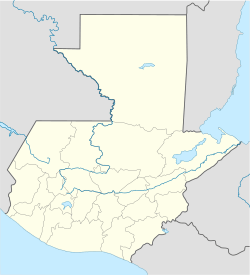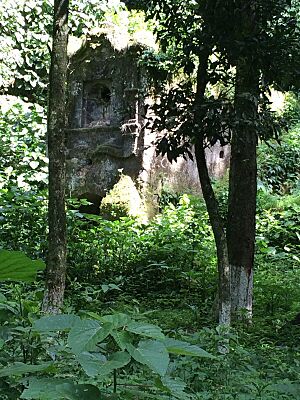Fraijanes facts for kids
Quick facts for kids
Fraijanes
|
||
|---|---|---|
|
Municipality of Guatemala
|
||
|
||
| Country | ||
| Department | Guatemala Department | |
| Area | ||
| • Total | 36.9 sq mi (95.5 km2) | |
| Elevation | 5,200 ft (1,585 m) | |
| Population
(2018 census)
|
||
| • Total | 58,922 | |
| • Density | 1,598.0/sq mi (617.0/km2) | |
| Climate | Cwb | |
Fraijanes is a town and a municipality in the Guatemala department of Guatemala. In 2018, its population was about 60,288 people.
Fraijanes is famous for its delicious coffee. This coffee has a slightly more acidic taste compared to coffee from Antigua Guatemala.
Contents
History
The name Fraijanes has an interesting story. In 1767, a group of priests called the Jesuits were asked to leave the Spanish colonies. They left behind a large farm, or hacienda, in the area that is now Fraijanes.
This farm was given to two other priests, Juan Milán and Juan Álvarez. People in the area respected and liked these priests very much. So, in 1860, they renamed the region "Frailes Juanes" to honor them. "Frailes" means "friars" or "brothers" (referring to the priests). Over time, the name changed a bit, first to "Fray Juanes" and then to "Fraijanes."
The Old Jesuit Farm
Back in 1646, the Fraijanes area was given to the Jesuits to set up a religious center. Today, there are old ruins there, but it's hard to tell exactly what they were used for. Some records suggest the area belonged to the Jesuits. Another idea is that the ruins are from a rich Spanish farm. This idea comes from a tunnel that supposedly connects the main house to a small church.
There are also some cool legends about these ruins. One popular story is called «La Cueva del Negro» (which means "The Black Man's Cave"). It tells of a slave who escaped and hid in the abandoned farm. He lived by finding corn and hunting small animals. But eventually, being alone made him go a little crazy. The legend says he became a scary person who bothered nearby towns until a farmer stopped him.
People of Fraijanes
Most people living in Fraijanes are Ladino, which means they have mixed European and Indigenous backgrounds. There is also a smaller group of Indigenous people. About 4% of the population belongs to other ethnic groups.
In 2018, the town had about 60,288 residents. Slightly more than half (52%) were men, and 48% were women. Most people (75%) lived in the town area, while 25% lived in the countryside.
Fraijanes has a young population! About 35% of the people are between 0 and 19 years old. Another 49% are between 20 and 49 years old.
The biggest towns and villages in the area are:
- The main town of Fraijanes
- Aldea El Cerrito
- Aldea Puerta del Señor
- Caserío Concepción Rabanales
Geography
Climate
Fraijanes has a subtropical highland climate. This means it has mild temperatures and a good amount of rain, especially during certain times of the year.
| Climate data for Fraijanes | |||||||||||||
|---|---|---|---|---|---|---|---|---|---|---|---|---|---|
| Month | Jan | Feb | Mar | Apr | May | Jun | Jul | Aug | Sep | Oct | Nov | Dec | Year |
| Mean daily maximum °C (°F) | 23.2 (73.8) |
24.2 (75.6) |
25.8 (78.4) |
26.3 (79.3) |
25.7 (78.3) |
24.1 (75.4) |
24.2 (75.6) |
24.5 (76.1) |
23.8 (74.8) |
23.4 (74.1) |
23.0 (73.4) |
22.9 (73.2) |
24.3 (75.7) |
| Daily mean °C (°F) | 17.7 (63.9) |
18.3 (64.9) |
19.5 (67.1) |
20.3 (68.5) |
20.3 (68.5) |
19.7 (67.5) |
19.6 (67.3) |
19.7 (67.5) |
19.4 (66.9) |
19.1 (66.4) |
18.2 (64.8) |
17.7 (63.9) |
19.1 (66.4) |
| Mean daily minimum °C (°F) | 12.2 (54.0) |
12.5 (54.5) |
13.2 (55.8) |
14.3 (57.7) |
15.0 (59.0) |
15.3 (59.5) |
15.1 (59.2) |
14.9 (58.8) |
15.0 (59.0) |
14.8 (58.6) |
13.5 (56.3) |
12.5 (54.5) |
14.0 (57.2) |
| Average precipitation mm (inches) | 5 (0.2) |
3 (0.1) |
10 (0.4) |
30 (1.2) |
203 (8.0) |
321 (12.6) |
245 (9.6) |
247 (9.7) |
316 (12.4) |
180 (7.1) |
37 (1.5) |
13 (0.5) |
1,610 (63.3) |
| Source: Climate-Data.org | |||||||||||||
Location
Fraijanes is located in the Guatemala Department. It shares borders with several other municipalities:
 |
Santa Catarina Pinula, Guatemala Department municipality | San José Pinula, Guatemala Department municipality |  |
|
| Villa Canales, Guatemala Department municipality | San José Pinula, Guatemala Department municipality Barberena, Santa Rosa municipality |
|||
| Barberena, Santa Rosa municipality | Barberena, Santa Rosa municipality |
Economy
Before 2010, Fraijanes mostly relied on farming. It was especially known for growing coffee and beans. However, many people started moving to Fraijanes from nearby towns. This led to the economy changing and becoming more focused on businesses and trade.
Fraijanes is working to improve the lives of its residents. For example, about 70.60% of homes in the municipality have access to clean drinking water. In 2008, Fraijanes ranked ninth among the municipalities in the Guatemala department for its human development index, which shows how well people are living.
Coffee Farming
Growing coffee is very important in Fraijanes. It's not just about money; it's also a big part of the town's culture. Local leaders have even promoted coffee growing as part of Fraijanes' identity.
Fraijanes is one of the five main coffee-producing regions in Guatemala. The types of coffee grown here include Arabica, Bourbon, Caturra, Catual, and Pache.
Education
Fraijanes offers education through both public and private schools. The Ministry of Education runs official public schools, like Mixed Rural School No. 818 in Don Justo village. Most public schools are in the main town center.
There are also "Cooperative Institutes" that provide basic education, usually from first to third grade. This level of education is needed before students can go on to college-level studies. For a long time, many students from Fraijanes would travel to Guatemala City for higher education, especially to private schools, because there weren't as many options in their own town.
Today, Fraijanes has many educational choices:
- 11 IGER (Guatemalan Institute of Radial Education) centers for primary, middle, and high school.
- 7 pre-primary schools.
- 21 primary schools.
- 6 middle school institutes.
- 1 college-level institute.
Education Statistics
The municipality is working to keep students in school. The percentage of students who leave school early is 3.38% for primary school, 3.73% for middle school, and 2.48% for high school. In 2002, about 17.7% of people in Fraijanes could not read or write. However, many children attend school: 94.11% for primary school, 36.32% for secondary school, and 15.3% for college.
Technical Training
Fraijanes also offers various technical courses. These are funded by the local government and are mainly for young and older women. The goal is to give women skills that can help them improve their financial situation.
Private Schools and Universities
As more families moved to Fraijanes, especially those with higher incomes, more private schools opened. Many of these private schools offer a very high level of education. One well-known private school is the Lycée Français Jules Verne, which is a French international school.
In 2014, the private University of the Istmo of Guatemala (UNIS) started operating in Fraijanes. While the public University de San Carlos de Guatemala is not based in Fraijanes, students can travel to its campuses in Guatemala City.
Two other private universities, Galileo University and Pan American University, also have branches in Fraijanes at the Marco Tulio Meda Mendoza Educational Complex. They offer classes for specific professions a few days a week.
See also
 In Spanish: Fraijanes para niños
In Spanish: Fraijanes para niños




